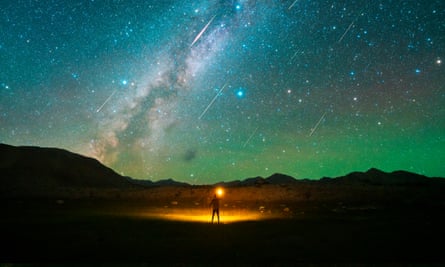Stargazers will be in for a treat this weekend as the best meteor shower of the year is expected to peak.
The Perseids are named after the Greek hero Perseus because the meteor shower appears to come from the eponymous constellation.
According to myth, Perseus slew the gorgon Medusa by cutting off her snake-covered head while viewing her reflection in his shield.
While the meteors are active from mid-July, the best time to see them is this weekend with the Perseids most visible in the northern hemisphere.
Derek Smale, the UK Space Agency’s programme manager for the ESA space safety and security programme, said: “The peak is expected to be Saturday night into Sunday but if anybody fancies a late night on Sunday night into Monday morning, it’ll probably still be very good.”
The Perseids arise when the Earth passes through dust that has been shed from the comet 109P/Swift-Tuttle.
Smale said: “As we travel through it, that stuff cascades into our atmosphere and it’s travelling at phenomenal speeds so [it] heats up,” adding that many of the fragments are no bigger than a grain of sand.
Comets, often called “dirty snowballs”, are primitive objects that formed at the same time as the solar system, about 4.6bn years ago.
Lucie Green, a professor of physics at University College London and president of the Society for Popular Astronomy, said: “It’s exciting to think that those tiny bits of dust are actually the leftover material from which the whole solar system formed. In that way, looking at this meteor shower has huge significance. Each streak of light a messenger from the past.”

Comet 109P/Swift-Tuttle swept through the inner solar system in 1992 and is not expected to return until 2125.
According to Nasa, up to 100 meteors can be seen streaking across the sky every hour during the Perseids shower – at least, Smale adds, where there are dark skies – with exceptionally bright meteors, known as fireballs, part of the show. Some fireballs can be as bright as Venus in the night sky, and even have colours of reds, blues or greens.
“They really can be dramatic,” said Smale, adding the lumps of rock that give rise to fireballs are about the size of a pea.
“Just because they are that much larger, there is that much more resistance against the atmosphere so they are heating up more and it is literally like watching a ball of fire coming across the sky – it’s really quite something when you see these,” he said.
While the Perseids will be visible in smaller numbers in the southern hemisphere, Smale notes stargazers there are still able to see another meteor shower, known as the Southern Delta Aquariids, that peaked last month.
For those in the northern hemisphere, the Perseids are likely to be quite a show, with Smale noting that the approaching new moon means the skies are darker than usual, while the weather forecast has improved, at least in the UK.
For a good view, he said, escape the bright lights of the towns and cities, put away your mobile phone and climb a hill, as getting above nearby trees and buildings will help your view of the sky.
“The more sky you can see, the better,” Smale said, adding that meteors can appear anywhere across the night sky. The advice to people is just get out and look up.”
Green said heading outside to spot some Perseids was a summer tradition. “The relatively warm nights mean you can stay outside for longer to look up and enjoy the show. I plan to take a reclining chair into my garden and lie back and wait!”
Join the exciting world of cryptocurrency trading with ByBit! As a new trader, you can benefit from a $10 bonus and up to $1,000 in rewards when you register using our referral link. With ByBit’s user-friendly platform and advanced trading tools, you can take advantage of cryptocurrency volatility and potentially make significant profits. Don’t miss this opportunity – sign up now and start trading!






Recent Comments